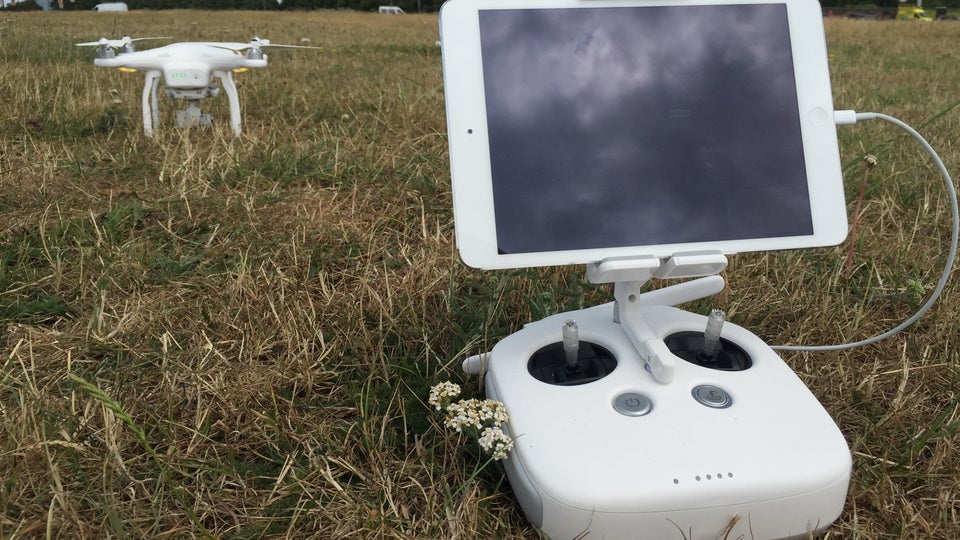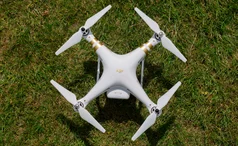DJI Phantom 3 Professional
DJI Phantom 3 Professional review

Stunning aerial photography comes at a price, but the Phantom 3 Professional is worth every penny
Specifications
Max Speed: 16 m/s (ATTI mode, no wind), GPS modes: GPS, GLONASS, VPS, Gimbal pitch: -90° to +30°, Gimbal stabilization: 3-axis (pitch, roll, yaw), Maximum photo resolution: 4096×2160 at 24/25fps, Maximum video resolution: 4096×2160 at 24/25fps, Flight time: 23 minutes, Weight: 1.2kg, Propeller span: 590mm diagonal
Remote-controlled quadcopters, more commonly known as drones, are big news right now. Unfortunately, this is partly down to irresponsible pilots flying too close to commercial airliners and public buildings, but for anyone more responsible who is interested in aerial photography, they are a gateway to capturing startling footage of the world from above. They are also, when flown safely, brilliant fun.
DJI is arguably the best-known drone manufacturer, and with good reason; its Phantom-badged drones are highly advanced, with integrated GPS for safe flying, intuitive controls and a brilliant tablet or smartphone app that gives you a live view from the camera mounted underneath its four rotors. The Phantom 3 Professional is the latest model in the range; with a longer-lasting battery and a camera capable of recording 4K footage, stabilised by a three-axis gimbal, it’s one of the most comprehensively specced drones you can buy today.
The drone
Like most consumer drones, the Phantom 3 uses a quad-rotor design for balanced flight. The 4K camera module is mounted below on a three-axis gimbal to keep your footage free from camera shake, while landing gear protects the electronics from bumps on touchdown.
A fully stabilised flight controller takes out almost all the challenge of flying, and integrated GPS ensures it stays in place when you want it to. When GPS is unavailable, DJI’s own visual positioning system (VPS) helps keep the Phantom 3 hovering; the downwards-facing camera and two ultrasonic sensors work brilliantly, creating a real-time map of the ground beneath the drone. It means you could feasibly use it indoors, but although it looks deceptively small, the propeller span of 590mm makes the Phantom 3 mostly suited to outdoor flight; for safety reasons as much as anything, as the propellers don’t have guards. In the open air, you can fly up to 400 feet vertically and get up to 1.2 miles away from the control unit.

The controller
The controller is incredibly comprehensive, with buttons for controlling the camera, start/stop recording and take still photos during flight, twin sticks for drone movement and a mounting point to attach a smartphone or tablet. It’s adjustable, meaning it will hold any phone or tablet up to the size of an iPad Air, and has a tight grip to ensure your device doesn’t fall out.
A USB port on the back lets you connect the tablet/phone and controller to enable live streaming from the Phantom’s camera in 720p resolution. Both iOS and Android are supported, so most people should be able to use the app. The controller finally has its own internal rechargeable battery, which is a huge improvement over the AA battery-powered controller that shipped with previous versions of the Phantom.

The DJI Pilot App
You don’t actually need to connect a mobile device in order to fly, but having the live view makes capturing stills and video much easier. The live view fills the majority of the screen, making it much easier to line up your shots than by eye alone. The free DJI Pilot app also gives you full control over camera shutter speed, ISO sensitivity, white balance, resolution and video frame rate, as well as automatic take-off and landing buttons, a GPS overlay indicating your altitude and a signal strength indicator showing the distance away from the controller.
The app also shows you the all-important flight time you have remaining; the Phantom 3 can last for up to 23 minutes on a single charge, although that drops if the drone has to fight strong winds. A warning appears when the battery is nearly empty, prompting you to return to your take-off site, and the Phantom will land automatically if the battery gets critically low.
New pilots can practice with the Phantom simulator, using the controller and the app, which mimics flying the actual drone using the same controls you’ll eventually need to pilot it outdoors. We found it very useful for practice when high winds prevented us from taking the Phantom outdoors.

The camera
It’s the 12.4-megapixel, f/2.8 camera bolted to the Phantom 3’s undercarriage that turns it from hobbyist toy into an aerial photographer’s dream. The 94-degree field of view virtually eliminates fisheye distortion, and avoids capturing the landing gear when taking stills or video. Our test shots looked incredibly punchy and vibrant, with an impressive level of detail, but it’s when recording video that the Phantom truly shines. The 4K footage captured by the Professional is pristine, rivalling anything we’ve seen from the likes of GoPro or other action cameras.
A less expensive model, the £900 Phantom 3 Advanced, drops video quality down to 1080p but retains all the other features found in the Professional version. It even uses the same sensor, so still image quality should match the Professional model.
The camera’s three-axis gimbal kept the image perfectly still when in flight, even when winds picked up to 10mph. We could spot a small amount of shake at top speed, but in steady flight you should be able to get perfectly stable shots. You can’t rotate the camera, meaning you have to turn the drone instead to get the shot you want. It takes a steady hand, especially when you’re also using the vertical tilt wheel to angle the lens up and down.

In flight
Out of the box, you simply have to screw a rotor blade onto each prop, plug in the battery pack and power the Phantom on before you’re ready to fly. Of course, it’s much more complicated than that here in the UK; the Civil Aviation Authority (CAA) is still in the process of defining rules and regulations for drone pilots, but until laws are passed users will need to follow the so-called Drone Code in order to stay within the law.
Essentially, you need to ensure you can see your drone at all times, don’t fly higher than 400 feet, keep it well away from aircraft, helicopters, airports and airfields, and above all use your common sense and fly safely – you could be prosecuted if you don’t. The Phantom 3, like all DJI drones, is geo-fenced to prevent it from accessing certain areas like airports, but you’ll still need to act responsibly when flying.
There are other factors to be aware of, too, because the Phantom 3 is fitted with a camera. You shouldn’t fly it within 50 metres of people, vehicles, buildings or structures, or large gatherings such as concerts and sports events. Finally, you can only fly drones on private property or public green land – otherwise you need to seek permission from the landowner in order to fly over it. This effectively limits your ability to (legally) fly, meaning you may have to travel, depending on where you live, in order to get in the air.
Conclusion
The Phantom 3 Professional is a brilliant way to get into aerial photography, with intuitive controls, comprehensive simulations to help you improve your flying abilities even when the drone is grounded, and stunning image quality. It’s undoubtedly expensive, but considering your footage is of the latest 4K standard and the drone is so easy to use that you don’t have to be an experienced radio-controlled aircraft pilot in order to fly it, we think it’s worth the investment if you’re looking to produce some stunning aerial video or photos.
| Hardware | |
|---|---|
| Drone type | Quadcopter |
| Max ascent speed | 5 m/s |
| Max Speed | 16 m/s (ATTI mode, no wind) |
| GPS modes | GPS, GLONASS, VPS |
| Gimbal pitch | -90° to +30° |
| Gimbal stabilization | 3-axis (pitch, roll, yaw) |
| Camera | |
| Sensor size | 1/2.3in |
| Sensor resolution | 12.4-megapixel |
| Sensor field of view | 94-degrees |
| ISO speed range | 100-3200 |
| Maximum aperture (wide-tele) | f/2.8 |
| Photo modes | Single Shot, 3/5/7 shot burst, 3/5 Auto Exposure Bracketing (AEB), Time-lapse |
| Photo file formats | JPEG, DNG (RAW) |
| Maximum photo resolution | 12.7-megapixel |
| Video compression format | MP4, MOV |
| Maximum video resolution | 4096×2160 at 24/25fps |
| Video resolutions | 3840×2160 at 24/25/30fps, 1920x1080p at 24/25/30/48/50/60fps, 1280x720p at 24/25/30/48/50/60fps |
| Maximum video bitrate | 60Mbps |
| Software | |
| Mobile app | DJI Pilot |
| Supported operating systems | Android 4.1.2 or later, iOS 8.0 or later |
| Physical | |
| Card slot | MicroSD |
| Memory supplied | None |
| Battery capacity | 4,480mAh |
| Flight time | 23 minutes |
| Weight | 1.2kg |
| Propeller span | 590mm diagonal |
Read more
ReviewsDJI Phantom 3 Professional review: This drone means business
DronesIncredibly easy to set up and pilot, the DJI Phantom 3 is a great way to take your drone obsession up a notch
DJI Phantom 3 Professional review
DronesStunning aerial photography comes at a price, but the Phantom 3 Professional is worth every penny


